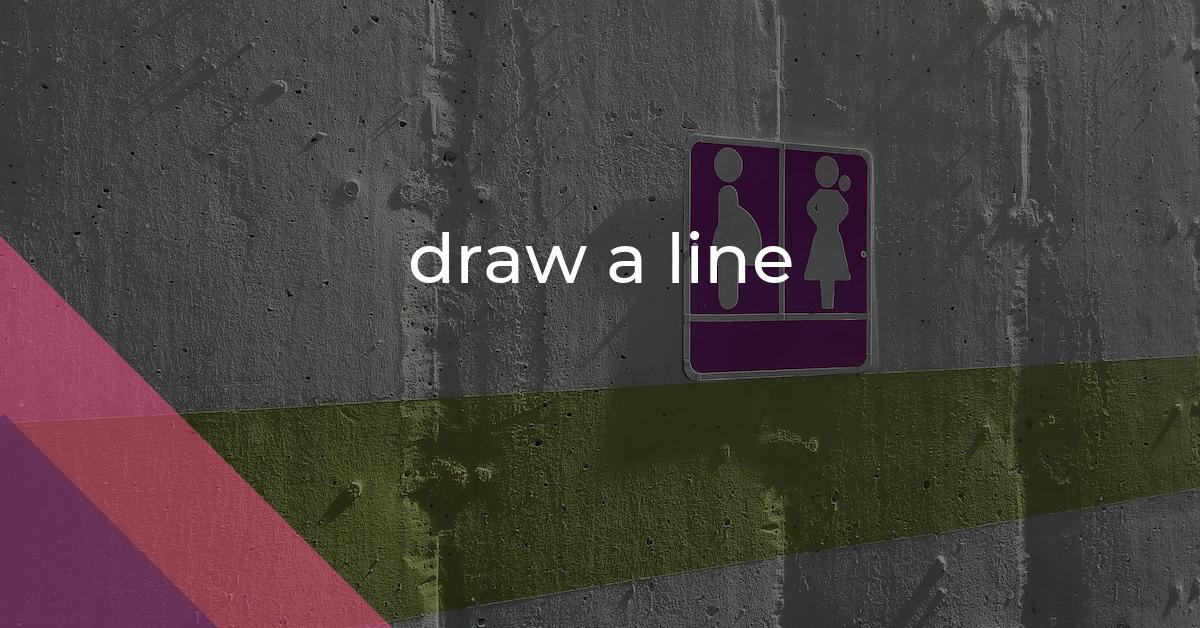draw a line: Idiom Meaning and Origin
What does ‘draw a line’ mean?
The idiom "draw a line" means to set a limit or establish a boundary, indicating the point where one thing ends and another begins.

Idiom Explorer
The idiom "lay on the line" means to take a risk or be open and honest about something, often exposing oneself to potential danger, criticism, or negative consequences.
The idiom "in line" means being in a position or sequence, typically waiting for something or following rules or instructions.
The idiom "hold the line" means to remain in a current position or keep a situation stable, often in the face of difficulty or opposition.
The idiom "give someone line" means to provide someone with an excuse or false information to deceive or mislead them. It is often used to imply manipulation or deceitful behavior.
The idiom "fine line" refers to a very narrow distinction or difference between two things or situations.
The idiom "fence in" means to enclose or confine someone or something within a limited space or boundaries, restricting their freedom or movement.
The idiom "draw the line" means to set a limit or establish a boundary beyond which one is unwilling to go or accept.
The idiom "draw stumps" means to end or finish an activity or an event abruptly.
The idiom "draw one's last breath" means to die or to take one's final breath before passing away.
The Boundary Marker
One idiom that is commonly used in everyday English is "draw a line." This phrase has multiple meanings and can be used in various contexts, both literal and figurative. To fully understand the idiom, it is important to explore its origins and examine its different uses.
First and foremost, the literal meaning of "draw a line" refers to physically marking a line on a surface using a writing instrument, such as a pencil or pen. This could be done to indicate a boundary, divide a space, or create a separation between two areas. The act of drawing a line in this sense is straightforward and can be traced back to ancient times when people would physically mark boundaries or areas for different purposes.
Figuratively, "draw a line" takes on a more symbolic meaning. It is often used to denote setting a limit or establishing a boundary between two things or ideas. This can be seen in expressions such as "draw the line at" or "cross the line," which indicate a point at which something is considered unacceptable, inappropriate, or intolerable. The idiom implies the need for individuals to define their personal or moral boundaries and to maintain them in order to protect themselves or their values.
In addition, "draw a line" is also used to express the notion of making a clear distinction or separating one thing from another. This can be observed in statements like "we need to draw a line between fact and fiction" or "it's important to draw a line between work and personal life." In these contexts, the idiom emphasizes the importance of differentiating or categorizing things properly to ensure clarity and understanding.
Furthermore, "draw a line" can convey the idea of making a decisive or definitive action. When someone says "it's time to draw the line," they are indicating that a point has been reached where a decision or action must be taken. This can be seen in situations where individuals need to assert themselves, set boundaries, or take a stand against a certain behavior or situation.
Examining the etymology of the idiom "draw a line" reveals its origins in physical actions associated with drawing or marking lines. Its metaphorical usage likely developed over time as people began to use the act of physically drawing a line as a way to symbolize setting boundaries or making distinctions. The idiom's flexibility and widespread use can be attributed to its effectiveness in conveying these concepts in a concise and understandable manner.
The idiom "draw a line" is a versatile expression that can be used to signify various concepts such as setting boundaries, making distinctions, taking a stand, and making decisive actions. Its literal meaning refers to marking a line physically, while its figurative usage conveys symbolic meanings associated with establishing limits and separating ideas or things. By understanding the multiple meanings and applications of this idiom, individuals can effectively communicate their intentions and assert themselves in different situations.
In addition to "draw a line," there are several related idioms that further enhance the understanding and usage of this expression.
One such idiom is "draw the line," which is often used interchangeably with "draw a line." However, "draw the line" is more commonly used in the context of setting boundaries or limits, particularly in relation to what is considered unacceptable or intolerable. For example, someone might say "I can tolerate a lot, but cheating is where I draw the line." This phrase emphasizes the importance of defining personal boundaries and sticking to them, even in challenging situations.
Another related idiom is "cross the line," which is the opposite of "draw the line." While "draw the line" implies the establishment of boundaries, "cross the line" refers to the act of exceeding or violating those boundaries. It suggests that someone has gone too far or engaged in behavior that is considered inappropriate or unacceptable. An example sentence could be, "I warned him not to insult my family, and when he did, he really crossed the line."
The idiom "fine line" is also closely related to "draw a line." It emphasizes the idea that there is a delicate or subtle distinction between two things or ideas. It suggests that the boundary or differentiation between them is not easily distinguishable. For instance, someone might say, "There's a fine line between genius and insanity," highlighting the notion that the boundary between exceptional creativity and mental instability can be blurred or difficult to define.
"blur the line" is another idiom that expands on the concept of "draw a line." It refers to the act of making the distinction or boundary between two things less clear or defined. It suggests that there is a degree of ambiguity or uncertainty in differentiating between the two. An example sentence could be, "The singer's style blurs the line between pop and rock, making it difficult to categorize her music."
Lastly, "cross out" is a related idiom that can be associated with "draw a line." It is often used to denote the act of deleting or removing something from a list, document, or written record. While "draw a line" focuses on establishing boundaries or distinctions, "cross out" emphasizes the elimination or disregard of something. For example, someone might say, "Let's cross out the irrelevant information and focus on the main points."
Example usage
Examples of how the idiom draw a line can be used in a sentence:
- After years of disagreement, they finally decided to draw a line and put an end to their feud.
- The company's new policy draws a clear line between acceptable and unacceptable behavior.
- It's important to draw a line between personal and professional life to maintain a healthy work-life balance.
More "Action" idioms



